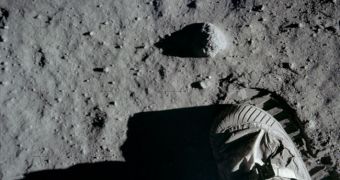Recent investigations by NASA's Lunar Crater Observation and Sensing Satellite (LCROSS) satellite have revealed in late 2009 that massive amounts of water-ice can be found at the lunar south pole. Though the area experiences extremely cold temperatures, and the craters there are among the coolest places in the solar system, researchers and astronomers at the European Space Agency (ESA) are already planning a mission to the location. The flight is scheduled to be unmanned, and the agency plans to put a lander on the surface of the planet's natural satellite in the not-too-distant future, Space Fellowship reports.
More than 40 years ago, Apollo astronauts set foot on the Moon, but at the time they landed in relatively smooth terrain, where there was a lot of room to maneuver. But the future ESA mission will not be so easy to plan and execute. The lunar south pole is an extremely rugged place, with high ridges marking the boundaries of very deep craters, where sunlight hasn't reached the bottom for millions of years. It is in this desolate landscape that ESA officials want to set down a lander, so that it could benefit from the advantages that the presence of ice brings.
At this point, ESA is launching a submissions campaign for proposals on how the Lunar Lander mission should take place. Representatives of the industry are expected to submit their proposals for the vehicles that would take scientific equipment there, as well as for how the entire flight would be set up and organized. There is a vast array of technical problems to consider as well, and the trip is no less dangerous now than it was when the United States sent its manned missions to the Moon. The case of the Apollo 13 mission is still vivid in the mind of many, and experts know that it was only luck, dedication and hard work under extreme stress conditions that saw the three astronauts returning home alive.
According to officials at the agency, there are two goals that proposal submitters need to keep in mind. The first is that the delivery vehicle and the spacecraft itself need to be extremely precise in their navigation instruments, so that they can be landed with extreme accuracy in this difficult terrain. The heavily-cratered terrain is the direct target of the mission. The second objective is for the lander to image the land below as it descends and recognize hazardous terrain using onboard artificial intelligence. Additionally, the spacecraft will need to be able to analyze its location with a large array of scientific instruments.

 14 DAY TRIAL //
14 DAY TRIAL //